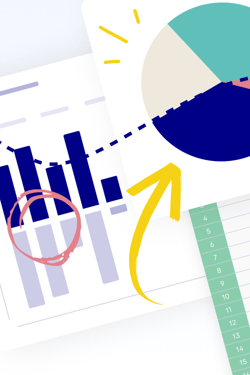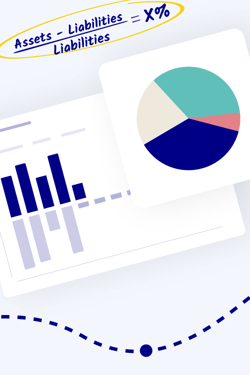Chapter 1
What are financial ratios?

How do you know if a company is "financially healthy?"
It's not just nice-sounding jargon.
CFOs use financial ratios to determine a company’s financial health.
Profitability, liquidity, solvency, and so on.
Two big reasons to analyze a company’s financial ratios:
- Track its financial performance over time
- Compare its performance to different companies (or the industry average)
Let's take a look at the most important ones.
The 5 most important financial ratios
Which ratios are the most important? It depends on the context.
For example, FP&A teams may focus more on the company’s immediate financial position.
At the same time, investors will want to understand its financial structure and long-term viability.
...if you're like, "just give me a few to know," you're in luck.
Here are the 5 most important financial ratios you should know:
- Quick ratio (AKA the acid test ratio)
- Debt-to-equity ratio
- Net profit margin
- Earnings per share
- Current ratio
Of course, you'll need more than these. That's why we wrote this guide. :)
Basic abbreviations to know
You’ll likely be familiar with many of this article's terms from your company’s financial statements.
But here's a quick refresher:
- COGS: Cost of goods sold. This includes materials, manufacturing processes, and labor costs associated with making your company’s products (or delivering its services).
- EBIT: Earnings before interest and tax. This means your company’s earnings before you make deductions for interest payments or taxes.
- EBITDA: Earnings before interest, tax, depreciation, and amortization. This is similar to EBIT but includes depreciation and amortization expenses to try and give you a more accurate picture of your company’s profit.
These are all terms (and calculations) you’ll use when calculating various financial ratios, so it’s helpful to familiarize yourself with what they mean and how to calculate them.
Quick tip: have your financial statements on hand
You should be able to find every number for calculating financial ratios in your company’s three financial statements. These include:
- Balance sheet
- Income statement
- Cash flow statement
Having these on hand will make it quicker to calculate your financial ratios, as you won’t need to dig through your files to find the correct numbers.
Chapter 2
Profitability ratios

You need to know how profitable the business is.
But you can slice and dice profit in tons of ways.
...So how do you measure profitability?
Profitability ratios. They help you understand the company’s financial well-being.
This financial ratio class also measures a company’s ability to profit from its revenue.
Let's take a look.
Contents
- Operating profit margin | Operating profit ratio
- Asset use profitability ratio
- Contribution profitability ratio | Contribution margin
- Gross profit margin
- Operating margin | EBIT margin
- Pretax margin ratio | Earnings before tax (EBT)
- Net profit margin
- Return on assets (ROA)
- Return on equity (ROE)
- Earning margin/EBITDA margin
- Return on capital employed | Return on investment (ROI)
- Earnings per share (EPS)
- Price-to-Earnings (P/E) ratio | Price multiple | Earnings multiple
- Price-to-Book (P/B) ratio
- Dividend payout ratio
- Dividend yield ratio
- LTV/CAC ratio
- EBITDA multiple | EV:EBITDA ratio
- SaaS magic number
- Hype factor ratio
- Burn multiple
- Bessemer efficiency score
1. Operating Profit Margin/Operating Profit Ratio
The operating profit margin, also called the operating profit ratio, tells you how much profit a business makes for every dollar of sales. It doesn't take tax or interest into account.
Here's how to calculate the operating profit ratio:
Operating profit ratio = (Operating profit ÷ Net sales) x 100
What is a good operating profit ratio?
A high operating profit ratio (> 20%) indicates good management of resources, such as good operational efficiencies, which leads to higher profitability.
A low operating profit ratio (< 5%) suggests that you're not making much profit compared to your total revenue generated, which makes it challenging to sustain and grow the business.
Want to improve a low operating profit ratio? Look at any operational challenges that prevent efficient resource management.
2. Asset Use Profitability Ratio
How efficiently does a company use its assets to generate profit?
Assets include value to your company, including cash, stock, office equipment, real estate, and product inventory.
The asset use profitability ratio is calculated after all operating expenses have been deducted from the revenue generated.
It's two subtypes are actually turnover ratios: the
To calculate the asset use profitability ratio, use the following formula:
Asset use profitability ratio = (Total revenue - Operating expenses) ÷ Total assets
What does your asset use profitability ratio mean?
The higher your asset use profitability ratio, the better your company generates profit from its assets.
On the other hand, a low ratio may indicate that you’re over-investing in business assets, which is eating into your profit margin.
3. Contribution Profitability Ratio/Contribution Margin
The contribution profitability ratio, also called the contribution margin, shows the percentage difference between sales and expenses.
Why is this financial ratio useful?
Because it helps you understand the company’s ability to generate a profit after variable expenses. It's a foundational calculation for break-even analysis.
To calculate the contribution profitability ratio, use the following formula:
Contribution profitability ratio = (Revenue - Variable expenses) ÷ Revenue
What is a good contribution profitability ratio/contribution margin?
A high contribution profitability ratio indicates a greater ability to cover expenses and overhead costs with revenue.
Put simply:
The closer to 100%, the better.
4. Gross Profit Margin
Gross profit margin calculates the amount of money left over from product sales after taking off the cost of goods sold (COGS).
It should be expressed as a percentage, not a dollar amount (like gross profit).
Use this formula to calculate the gross profit margin:
Gross profit margin = (Net sales - COGS) ÷ Net sales
What is a good gross profit margin?
There's no rule of thumb for a "good" gross profit margin because it varies across industries and business types.
According to CFO Hub, here are some average gross profit margins for different sectors:
- Software (Internet) — 58.58%
- Advertising — 23.99%
- Retail (general) — 24.27%
- Retail (online) — 42.53%
Don’t see yours here? Check the complete list in their article.
5. Operating Margin/EBIT Margin
A company’s operating margin tells you how much profit it makes after subtracting operating costs. It's also sometimes called EBIT margin.
This financial ratio measures the company's profit after paying for production costs such as wages and raw materials.
These costs vary over time—they’re not fixed costs. So operating margin is But the operating margin doesn’t consider deductions for interest payments or taxes.
The formula for operating margin is:
Operating margin = Operating profit ÷ Total revenue
What is a good operating margin?
In general, a higher operating margin is considered better than a lower one.
The average total market operating margin is 13.13%, but a “good” operating margin varies across industries and company types as with gross profit margin. Here are some examples:
- Financial services — 17.99%
- Publishing and newspapers — 8.43%
- Software (entertainment) — 33.55%
NYU Stern School of Business has collated data across multiple industries for average operating margins. Check their full list to find the industry closest to yours, to help you benchmark yours.
6. Pretax Margin Ratio/Earnings Before Tax (EBT)
Pretax margin is also called the Earnings Before Tax (EBT) ratio.
This financial ratio helps you understand a company’s profitability before considering deductions for tax expenses.
It helps assess a company's profitability and YoY organic growth because it focuses purely on your revenue.
To calculate your pretax margin ratio, use the following formula:
Pretax margin ratio = Earnings before tax ÷ Revenue
Understanding your pretax margin ratio
A higher pretax margin ratio means your company has a more profitable operating model.
Measuring it year-on-year helps you see the impact of significant business decisions on your profits (for example, changing suppliers or raising prices) before deducting taxes.
It also helps compare the performance of companies that operate in different states or countries that may have different levels of tax to pay.
7. Net Profit Margin
Net profit margin is a financial ratio for calculating the percentage of profit your company produces from all the revenue it generates.
It measures the net profit for every dollar of revenue, considering the cost of goods sold, operating expenses, interest payments, and tax deductions.
To calculate the net profit margin, use the following formula.
Net Profit Margin = (Net Profit ÷ Revenue) x 100
What does a good net profit margin look like?
A “good” net profit margin will depend on your industry and the stage of your company. A higher net profit margin generally indicates a stronger financial position.
According to the NYU Stern School of Business, the average net margin is 8.89%, but it varies across industries. For example:
- Advertising — 3.79%
- Bank (regional) — 30.31%
- Software (internet) — -19.07%
Check their full list to find the industry closest to yours to benchmark your net profit margin.
8. Return on Assets (ROA)
The return on assets ratio helps you understand how profitable your company is relative to its total assets.
The ratio compares its total assets with its earnings after tax and interest.
For example, this could include tangible assets such as real estate, manufacturing machinery, and inventory, or intangible assets like intellectual property.
Use the following formula to calculate your return on assets ratio:
Return on assets = (Net income ÷ Total assets) x 100
Understanding your return on assets ratio
A higher return on assets ratio indicates you’re in a better financial position than a lower ROA ratio.
However, average ROA ratios vary considerably between industries and company types.
So it’s best to benchmark yourself against similar companies.
9. Return on Equity (ROE)
The return on equity ratio measures your company’s profitability compared to your shareholders’ investment.
It gives you a simple metric for evaluating investment returns.
You calculate it by dividing your net income by shareholder’s equity, which is equal to your company’s net assets. So another way to think of ROE is as your return on net assets.
To calculate your return on equity, use the following formula:
Return on equity = Net income ÷ Shareholders’ equity
What is a good return on equity ratio?
The higher your return on equity ratio, the better your company converts its equity into profits.
Investors often look at the long-term average of the S&P 500 for a benchmark, so an ROE of 14% is about average.
10% and under is considered a poor return.
However, ROE varies between industries. So you have to look at your industry's average to correctly interpret your company’s performance.
10. Earning Margin/EBITDA Margin
The earning margin is also known as the EBITDA margin.
This financial ratio helps you understand your operating profitability and is a crucial metric for comparing your company’s performance against others in your industry.
To calculate your earning margin, use the following formula:
Earning margin = EBITDA ÷ Total revenue
Understanding your earning margin/EBITDA margin
A high earning margin means the business is relatively stable.
In contrast, a lower earning margin suggests the company may have cash flow and profitability problems.
Investors value the earning margin/EBITDA margin because it removes the effects of non-cash expenses, such as depreciation and amortization, that can skew profitability calculations.
So this financial ratio makes it easy for investors to compare the relative profitability of multiple companies in the same industry.
Quick caveat: because EBITDA isn't a GAAP (generally accepted accounting principles) metric, you should put earning margin in perspective with other ratios.
11. Return on Capital Employed (ROCE)/Return on Investment (ROI)
Return on capital employed (ROCE), also called return on investment (ROI), helps you understand how well your company generates profits from its capital.
Put simply:
It tells you how much profit you generate from every dollar employed. It’s similar to return on invested capital, so we’ve grouped them.
To calculate your ROCE, use the following formula:
Return on capital employed = EBIT ÷ Capital employed
Total capital employed is similar to invested capital, which you calculate by subtracting your current liabilities from the company’s total assets.
What is a good return on capital employed (ROCE)/return on investment (ROI) ratio?
A high return on capital employed ratio (>20%) is a good sign. A higher ROCE ratio tends to indicate the company is profitable.
But what counts as a good ROCE ratio varies considerably between industries.
So if you’re using this financial ratio to benchmark your company’s financial health, make sure you’re comparing against other companies in the same space.
12. Earnings per Share (EPS)
The earnings per share ratio shows the company’s net income per share if all its profits were distributed to shareholders.
It’s a helpful indicator of your company’s profitability, and investors often use it to estimate its value.
Use the following formula to calculate your earnings per share ratio:
Earnings per share = (Net earnings - preferred dividends) ÷ Total shares outstanding
Understanding your earnings per share ratio
In general, a high EPS ratio is better than a low one.
The higher your earnings per share ratio, the more profitable your company is.
A higher EPS indicates a higher company value because it has more profits than expected relative to its share price.
13. Price-to-Earnings (P/E) Ratio/Price Multiple/Earning Multiple
The price-to-earnings ratio is a stock valuation metric known as the price multiple or earnings multiple.
It compares your company’s share price to its earnings per share.
It's used to determine the relative value of a company’s shares—either in comparison with other companies or against the company’s historical performance.
To calculate your P/E ratio, use the following formula:
Price-to-earnings ratio = Market value per share ÷ Earnings per share
There are two types of P/E ratios: trailing and forward-looking.
Trailing P/E is calculated using the earnings per share over the last 12 months.
Forward P/E uses a predicted EPS to estimate future stock valuation.
Additionally, if your company has no earnings or is losing money, it won’t have a P/E ratio. This is because it won’t have any earnings per share to include in the calculation.
Understanding the price-to-earnings ratio/price multiple/earnings multiple
Investors use the P/E ratio to determine the value of a company.
A “good” price-to-earnings ratio depends on industry.
Still, the average P/E ratio for S&P 500 Index Stocks has historically been around 15, though it’s currently higher (18 at this writing in Q4 2022, and 29 in Q1 2022).
14. Price-to-Book (P/B) Ratio
The price-to-book (P/B) ratio compares a company's market valuation to its book value.
(Book value is the net, liquid difference between a company's total assets and liabilities.)
Investors use the price-to-book ratio to assess potential investments.
Here's the price-to-book ratio formula:
P/B Ratio = Market price per share ÷ [(Total assets - intangible assets - total liabilities) ÷ number of outstanding shares]
Or, more simply:
P/B Ratio = Market price per share ÷ Book value per share
Understanding your price-to-book (P/B) ratio
What determines a good price-to-book ratio depends on the industry.
But generally, a good P/B ratio is under 1.0.
Investors use the P/B ratio to find undervalued stocks.
(If your company's stock is undervalued, you have two options: tell the world or keep mum.)
15. Dividend Payout Ratio
The dividend payout ratio is also known as the payout ratio. It tells you the number of dividends paid to shareholders relative to your company’s net income.
To calculate your dividend payout ratio, use the formula below:
Dividend payout ratio = Dividends paid ÷ Net income
Understanding the dividend payout ratio
A low dividend payout ratio means companies reinvest their earnings into the business.
In contrast, a higher dividend payout ratio means more income gets paid out to shareholders instead.
One isn’t necessarily better than the other—it depends on the company’s size, stage, and overall financial health.
For example, a high dividend payout ratio may mean a company is trying to make itself more attractive to investors
...or that is has conservative growth that won’t require a significant financial investment in the coming months or years.
16. Dividend Yield Ratio
The dividend yield ratio tells you how much a company pays out in dividends each year compared to its stock price.
It measures the percentage of a company’s share price paid to its shareholders in the form of dividends.
The formula for calculating your dividend yield ratio is:
Dividend yield = Dividends per share ÷ Price per share
Investors often use this financial ratio to assess whether a company is a good fit for its investment portfolio.
For example, some investors will prioritize dividend returns and look for companies with a higher dividend yield ratio.
But others will focus more on capital gains, in which case a lower ratio will be a better fit for them.
Understanding your dividend yield ratio
Generally, a dividend yield between 30-50% can be considered healthy.
If your dividend yield ratio is >50%, that may be unsustainable long-term.
However, a “good” dividend yield ratio will vary across industries and company maturity.
For example, a fast-growing scale-up may not pay shareholder dividends as that money gets reinvested into the growth of the business.
17. LTV/CAC Ratio
The LTV/CAC ratio compares an average customer's lifetime value (LTV) with the cost to acquire that customer (CAC).
Whether you're a SaaS company that operates on a subscription model or a brick-and-mortar building a loyal buyer case, you need to know your LTV/CAC ratio.
LTV/CAC Ratio = [(MRR ÷ # of users) x (1 ÷ monthly churn rate)] : [Sales & Marketing Spend ÷ # of New Customers Acquired]
Understanding the LTV/CAC ratio
The LTV/CAC ratio evaluates your sales and marketing function.
A low LTV/CAC ratio means you're spending too much to acquire customers. An LTV/CAC ratio < 1 is a red flag. It means you're burning through cash and must pivot to more economical strategies.
But a high LTV/CAC ratio means you're getting a positive ROI on sales and marketing.
An ideal benchmark LTV/CAC ratio in SaaS is 3:1.
(In other words, customers should pay you 3x what you spent to acquire them.)
A ratio of 4:1 or higher is excellent.
Read more ➡️ LTV/CAC Ratio: your secret technique to measure sales & marketing ROI
18. EBITDA Multiple (EV:EBITDA Ratio)
EBITDA multiple, also known as enterprise value (EV) to EBITDA ratio, measures a company's value in the context of acquisition desirability.
Here's the formula:
EBITDA multiple = EV ÷ EBITDA
You can calculate EV by adding market capitalization to debt and subtracting cash and cash equivalents.
Understanding the EBITDA multiple
Most companies' EBITDA multiple will fall between 1 and 10.
At the simplest level, a company with a low EBITDA multiple is considered a low risk for acquisition.
Why?
Because a low EV:EBITDA ratio suggests it stock is undervalued.
On the other hand, a high EV:EBITDA ratio could also be a symptom of high growth with low current earnings but the potential for higher future earnings.
So it's hard to use EBITDA multiple in isolation to measure whether or not a company makes for a desirable acquisition.
Determining whether an EBITDA multiple is high or low depends on the industry.
According to Siblis Research, the average EBITDA multiple for Fortune 500 companies at the end of 2022 was ~13.156.
All sectors saw declines in their EBITDA multiple, except for Utilities, which saw a marginal increase.
19. SaaS Magic Number
The SaaS magic number is a growth flag for SaaS companies.
It measures the ROI on sales and marketing and tells you when it's time to pour money into growth.
It's super easy to calculate and interpret.
Here's the SaaS magic number formula:
SaaS magic number = [4* (QRR[X] – QRR[X-1])] ÷ (Sales + Marketing Expenses[X-1])
Where QRR[X] is the current quarter's recurring revenue and QRR[X-1] is that of the previous quarter.
How to interpret the SaaS magic number
Since the SaaS magic number is a growth flag, there's little nuance.
Here's the general rule of thumb:
≤ 0.75 🛑 You're not ready to put more money into growth. Focus on optimizing your existing spend and learning to generate sales.
≥ 0.75 but ≤ 1.0 ⚠️ You're probably ready for growth, but you should focus on tightening your conversion rates a little more.
≥ 1.0 ✅ Time to increase your sales & marketing spend and grow!
Read more ➡️ Calculating the SaaS magic number
20. Hype Factor Ratio
Hype factor was coined by investor Dave Kellogg as a new SaaS metric.
It's pretty simple: how do you quantify the hype around a company?
Here's Kellog's thesis in a nutshell:
- SaaS companies convert venture capital into (1) annual recurring revenue (ARR) and (2) hype
- ARR becomes GAAP revenue
- Hype drives interest in the company
- Interest in a company leads to an increase in ARR
This makes intuitive sense—buyers, especially in B2B, are more likely to purchase from brands and companies they feel connected to.
With that in mind, let's calculate the hype factor ratio:
Hype Factor = Capital Raised ÷ ARR
How to interpret your hype factor ratio
Kellogg makes this easy for us in his analysis. Here are some ranges for a good hype factor:
- A hype factor of 1-2 is the target
- A hype factor of 2-3 is good, esp. before IPO
And here are ranges for a bad hype factor:
- A hype factor of 3-5 suggests too much hype and too little ARR
- A hype factor of 5+ suggests there's very little there
But the hype factor ratio also has some limitations:
- It doesn't account for much VC money left over on the eve of the IPO
- It doesn't account for company debt
- It doesn't discriminate between company industries or categories
- Some companies don't separate subscriptions and services revenue, skewing their ARR higher than others that do
So even though you might not get asked for your hype factor ratio that often, it's good to be aware of what it is and how to get it.
21. Burn Multiple
Burn multiple is a capital efficiency metric that tells you how much money it costs to generate new revenue.
It's a popular metric among investors and venture capital firms for evaluating investment opportunities.
Burn multiple lets companies show cash management improvements and revenue increases over time, so it's good for getting a holistic sense of a business's cash efficiency.
Here's how to calculate burn multiple:
Burn multiple = net burn ÷ net new ARR
Interpreting your burn multiple
The closer to 0, the better.
An excellent burn multiple is < 1. This means the company makes more than $1 for every $1 spent.
A healthy burn multiple is between 1 and 2, depending on the size and stage of the company. Early-stage companies can tread closer to 2.
A poor burn multiple is anything over a 2, while anything over a 3 is a red flag.
22. Bessemer Efficiency Score
Bessemer Efficiency Score tracks net new ARR against net burn for a given period.
This financial ratio measures a company's spending habits by showing ARR dollars added for every dollar burned.
Bessemer Venture Partners developed it.
Here's the formula:
Efficiency score = Free cash flow margin of ARR + ARR YoY Growth Rate
How to interpret your Bessemer efficiency score
Bessemer encourages their portfolio companies to target different scores depending on ARR.
A good score at an ARR between $25-50MM is 70%.
A good score at $100MM+ of ARR is 50%.
Bessemer reports that, in September of 2021, the average BVP Nasdaq Emerging Cloud Index efficiency score across all companies was about 50%.

Chapter 3
Solvency, financial risk, and capitalization ratios

How do investors separate the good eggs from the bad?
In other words: how do you show that your company's assets outweigh its debts?
That you're not a financial risk.
Easy. Solvency ratios.
Solvency ratios help you understand your company’s long-term financial position.
And we're going to cover all the major ones in this chapter.
Contents
- Interest coverage ratio
- Fixed interest coverage ratio
- Fixed dividend coverage ratio
- Debt-to-assets ratio
- Shareholder-equity ratio
- Debt-to-equity ratio
- Debt-to-capital ratio
- Degree of combined leverage (DCL)
- Debt service coverage ratio
- Fixed charge coverage ratio
- Long-term debt-to-capitalization ratio
- Total debt-to-capitalization ratio
23. Interest Coverage Ratio
The interest coverage ratio helps you understand how easily a company can cover the interest payments on its outstanding debt.
Lenders and investors use this financial ratio to measure the risk of lending to a business, and as a short-term measure of a company’s financial health.
To calculate the interest coverage ratio, use the following formula:
Interest coverage ratio = EBIT ÷ Interest
Understanding your interest coverage ratio
Generally, a higher interest coverage ratio is better, and a low one can cause concern.
For example, if the ratio is <1, the company can’t cover its interest payments with its earnings. This means it will need to dip into its cash reserves or borrow further to make those payments.
24. Fixed Interest Coverage Ratio
The fixed interest coverage ratio is also known as the fixed charge coverage ratio.
It tells you how easily a company can cover its fixed charges (like debt payments, interest payments, office leases, and equipment lease costs) with its earnings.
Use the following formula to calculate your fixed interest coverage ratio:
Fixed interest coverage ratio = (EBIT - Fixed charges before tax) ÷ (Fixed charges before tax + interest)
Understanding your fixed interest coverage ratio
The higher your fixed interest coverage ratio, the better. It means you can cover your fixed charges and interest more times out of your earnings.
On the other hand, a low ratio means you may struggle to cover those costs, making your company a riskier option for lenders or investors.
Many lenders will need companies to meet a minimum fixed interest coverage ratio to approve them for loans. This is typically between 1.0 and 1.25.
25. Fixed Dividend Coverage Ratio
The fixed dividend coverage ratio tells you the number of times your company can pay dividends to its shareholders.
To calculate your dividend coverage ratio, use the following formula:
Fixed dividend coverage ratio = Net income ÷ Required dividend payout
Understanding the fixed dividend coverage ratio
The higher your dividend coverage ratio, the better your company can pay dividends to its shareholders.
A high ratio (>2) indicates that your company is in an excellent financial position, but it can be affected if your net income drops or the company issues more shares.
A low ratio (<1.5) may be a cause for concern.
26. Debt-to-Assets Ratio
The debt-to-assets ratio measures a company's debt levels relative to its assets.
This financial ratio helps you understand the company’s funding structure and how much it is funded by borrowings (debt).
You should include both short-term and long-term debt in this calculation.
Use the following formula to calculate your company’s debt-to-assets ratio:
Debt-to-assets ratio = Total debt ÷ Total assets
Understanding your debt-to-assets ratio
There isn’t an “ideal” debt-to-assets ratio, and it’s hard to compare against other companies—even those of a similar size and in the same industry as you.
But in general, a high ratio indicates a higher level of borrowing. Lenders will use this financial ratio to understand how likely your company is to be able to repay further borrowing.
In contrast, investors will use it to see whether the company will likely deliver a return on its investment.
27. Shareholder-Equity Ratio
The shareholder-equity ratio tells you how much of your company’s assets have come from issuing equity shares rather than borrowing and taking on debt.
To calculate your shareholder equity ratio, you first need to calculate your total shareholder equity by subtracting the company’s liabilities from its assets.
Then, use the following formula to work out your shareholder-equity ratio:
Shareholder-equity ratio = Total shareholder equity ÷ Total assets
Understanding your shareholder equity ratio
This financial ratio indicates how financially stable your company may be long-term.
A low ratio means a company has used more debt to pay for its assets.
A high ratio (>50%) means more assets are financed with equity capital.
28. Debt-to-Equity Ratio/Net Gearing Ratio
The debt-to-equity ratio is also called the debt-equity ratio or net gearing ratio. It measures the proportions of debt and equity your company uses to finance its assets.
This financial ratio tells you whether your company gets more financing from debt or equity capital.
To calculate your debt-to-equity ratio, use the following formula:
Debt-to-equity ratio = (Short term debt + Long term debt) ÷ Shareholder equity
How to interpret your debt-to-equity ratio
The higher your debt-to-equity ratio, the more your company relies on borrowed money rather than equity.
The company’s ratio will change as it grows and matures. A “good” ratio depends on your growth stage and your industry.
For example, a fast-growing startup will likely have a higher debt-to-equity ratio than a mature business, as it uses borrowing to fund its rapid growth.
So while a high debt-to-equity ratio may suggest a company is using borrowed money to grow, it’s not always an indicator of poor financial health.
Similarly, a low ratio isn’t always a good thing.
29. Debt-to-Capital Ratio
The debt-to-capital ratio helps you understand a company’s capital structure and financial solvency. It looks at how the business is funded, comparing the proportion of debt and capital.
Use the following formula to calculate your debt-to-capital ratio:
Debt-to-capital ratio = Debt ÷ (Debt + Shareholder equity)
Understanding your debt-to-capital ratio
For investors, the debt-to-capital ratio is used to interpret a company's risk.
The higher the debt-to-capital ratio, the riskier the investment because the company is more funded by debt than equity.
However, a higher ratio isn’t always bad if borrowing is done strategically to fuel growth in the business.
30. Degree of Combined Leverage (DCL)
The degree of combined leverage is a leverage ratio that helps companies understand the effects of combining financial and operating leverage on the company’s total earnings.
Finance teams can use this financial ratio to determine a business's optimal financial and operating leverage levels.
To calculate the degree of combined leverage, you first need to calculate your degree of financial leverage (DFL) and degree of operating leverage (DOL):
Degree of financial leverage = % change in earnings per share ÷ % change in EBIT
Degree of operating leverage = % change in EBIT ÷ % change in sales
You can then use the following formula to calculate your degree of combined leverage:
Degree of combined leverage = % change in earnings per share ÷ % change in sales = DOL x DFL
Understanding your DCL ratio
Investors will use this financial ratio to understand the riskiness of your company as an investment.
If you have a relatively high level of combined leverage, your company will be seen as a riskier investment than one with less combined leverage.
High leverage means your company has more fixed costs to manage.
31. Debt Service Coverage Ratio
The debt service coverage ratio helps you understand how easily a company can cover its debt obligations (including interest and principal repayments) from its available cash flow.
It helps investors understand whether a company generates enough income to pay its debts.
Use the following formula to calculate your debt service coverage ratio:
Debt service coverage ratio = Net operating income ÷ Total debt service
What does your debt service coverage ratio mean?
The lower your debt service coverage ratio, the harder it will be for your company to repay its debts.
A low ratio (<1) means your company doesn’t have enough income to cover those payments.
Lenders often have minimum requirements, but there isn’t an industry standard for a target ratio to be approved for additional borrowing.
32. Fixed Charge Coverage Ratio
The fixed charge coverage ratio shows how easily your company can cover its fixed expenses with earnings.
Fixed charges are expenses your company needs to pay regularly that aren’t affected by your other business activities.
Some examples: office rentals, utilities, equipment expenses, debt, and interest payments.
To calculate your fixed charge coverage ratio, you’ll need to know all your fixed charges before tax. Then, use the following formula to calculate the ratio:
Fixed charge coverage ratio = (EBIT - Fixed charges before tax) ÷ (Fixed charges before tax + interest)
Understanding your fixed charge coverage ratio
A higher ratio (>2) suggests your company can cover its fixed charges based on its current earnings.
On the other hand, a low ratio (<1.25) indicates the company may struggle to meet its fixed payment obligations and be less able to afford additional borrowing.
33. Long-Term Debt-to-Capitalization Ratio
The long-term debt-to-capitalization ratio shows a company's financial leverage.
It's a variation of the traditional debt-to-equity ratio.
Long-term debt-to-capitalization ratio = Long-term debt ÷ (Long-term debt + Shareholders' equity)
Understanding your long-term debt-to-capitalization ratio
Long-term debt—especially at low interest rates—can lower a company's total cost of capital.
This is because lenders don't share in profits or stock appreciation.
But interpreting this financial ratio depends on a business's ability to sustain profits in the long term to pay off its debts.
So a high long-term debt:capitalization ratio can be worrying because it signals this company might be at risk of defaulting on a lot of debt.
While a low long-term debt:capitalization ratio signals a much safer investment.
But remember this:
Debt isn't inherently bad. Companies take on debt to grow faster.
So always check the long-term debt:capitalization ratio in the context of revenue and growth rates.
34. Total Debt-to-Capitalization Ratio
The total debt-to-capitalization ratio measures a company's total debt as a percentage of capitalization.
The formula is pretty easy: just divide total debt by debt plus equity.
Total debt-to-capitalization ratio = (Short-term debt + long-term debt) ÷ (Short-term debt + Long-term debt + Shareholders' equity)
How to interpret the total debt-to-capitalization ratio
Just like other capitalization and leverage ratios, a good or bad total debt:capitalization ratio depends on the company's context.
A high debt:capitalization ratio signals an inherently more risky company than a low debt:capitalization ratio.
But it might also signal a high-growth company.
So you have to look at other ratios to put this in context, like the interest coverage ratio.

Contents
- Quick ratio/acid test ratio
- Current ratio
- Cash ratio
- Operating cash flow ratio
- Times interest earned ratio
35. Quick Ratio/Acid Test Ratio
The quick ratio (or acid test ratio) measures whether a company’s liquid assets can cover its current liabilities.
(Liquid assets are business assets that can be converted into cash quickly, such as cash and marketable securities.)
In other words: the quick ratio assesses a company's liquidity.
Use the following formula to calculate the quick ratio:
Quick ratio = (Current assets – inventories) ÷ current liabilities
What is a good quick ratio?
A quick ratio of 1 is considered average. A good quick ratio is > 1, and a bad one is < 1.
Suppose your company has a quick ratio of below 1. In that case, it may not be able to meet its immediate financial obligations because it doesn’t have enough assets to be liquidated if needed.
Read more ➡️ Quick Ratio vs. Current Ratio: What's the difference?
36. Current Ratio
The current ratio measures a company’s ability to meet its short-term financial obligations—typically, due within one year.
It helps you understand whether your company can cover its short-term debt with its existing assets. Its assets include cash, cash equivalents, accounts receivable, and inventories.
This may seem similar to the quick ratio, but inventories are generally excluded from quick ratio calculations.
Use this formula to calculate the current ratio:
Current ratio = Current assets ÷ current liabilities
What is a good current ratio?
A current ratio of 1 and above is a good sign. If your current ratio is >1, it suggests you have enough assets to remain solvent short term.
However, a current ratio <1 indicates that your company wouldn’t have enough capital to meet its short-term financial obligations if they were all due at once.
Read more ➡️ Quick Ratio vs. Current Ratio: What's the difference?
37. Cash Ratio
The cash ratio measures a company's ability to cover debt obligations with cash and near-cash options (like marketable securities).
It's a more conservative look at a company's liquidity because it only accounts for a company's cash.
So when used with other liquidity ratios, it gives more context to a "worst-case" scenario.
Here's the cash ratio formula:
Cash ratio = [Cash + cash equivalents] ÷ Current liabilities
How to interpret the cash ratio
Generally: the close to 1, the better.
A cash ratio ≥ 1 means a company has the cash to cover its current liabilities. But it also might mean the company is managing cash inefficiently.
A cash ratio of ≤ 1 means that a company doesn't have the cash to cover its current liabilities and would need to liquidate other assets.
But if the company has a positive cash flow and extended debt terms with lenders, this is less of an issue than it may appear.
38. Operating Cash Flow Ratio
The operating cash flow ratio measures how easily a company can cover its current liabilities with cash flows generated by its normal operations.
It calculates the times a company can pay off its debts with the cash flow generated over the same period.
This is also known as cash flow from operations—the company’s cash flow after you’ve deducted its operating expenses.
To calculate the operating cash flow ratio, use the following formula:
Operating cash flow ratio = Current liabilities ÷ Operating cash flow
What is a good operating cash flow ratio?
In general, a high operating cash flow ratio is better than a low one:
- Good: If your operating cash flow ratio is >1, your company generates more cash than it needs to pay off its current liabilities.
- Bad: If the ratio is <1, the company hasn’t generated enough cash to cover its liabilities, which is generally an indicator of poor financial health.
39. Times Interest Earned Ratio
The times interest earned (TIE) ratio is also called the interest coverage ratio.
It measures how many times a company could cover its interest charges from its earnings. It’s an indicator of a company’s ability to pay its debts.
You can use this formula to calculate your TIE ratio:
TIE ratio = EBIT ÷ Total interest payable on all debt
Understanding your TIE ratio
A higher TIE number means your company has enough cash left after paying its debts to invest in the business.
A TIE ratio of 2.5 and above is often seen as a “good” ratio.
But a low TIE number means the company has less breathing room with its finances.
In this case, a company may have a higher probability of defaulting on its loans, making it a riskier option for lenders and debt providers.

Chapter 5
Stability ratios

Nobody wants a financially risky company.
So what's the best way to show your company is built on a rock-solid foundation?
Stability ratios will get you most of the way there.
Investors and finance teams use them to assess a company’s level of financial security.
(And to assess how risky of an investment that company is.)
You'll learn about the most common stability ratios in this chapter.
Contents
- Operating leverage ratio
- Financial leverage ratio
- Total leverage ratio
- Fixed asset ratio
- Current/fixed asset ratio
- Proprietary ratio
40. Operating leverage ratio/Operational gearing ratio
The operating leverage ratio tells you what proportion of your company’s costs are fixed costs rather than variable ones.
For example, fixed costs include team salaries and office rentals and don’t change depending on business performance.
But variable costs may fluctuate depending on sales performance—for example, shipping or delivery charges.
You must first calculate your company’s contribution margin to calculate your operating leverage ratio. That is your revenue minus variable expenses.
Then use the following formula:
Operating leverage ratio = Contribution margin ÷ Net operating income
What does my operating leverage ratio mean?
If your company has high fixed costs compared with its variable costs, it has a high operating leverage ratio.
If you have a high operating leverage ratio, your fixed costs make up most of your business costs.
Therefore, fluctuations in sales performance have a smaller impact on your financial stability.
However, this means you need to maintain a high sales volume to cover your fixed costs in the first place.
41. Financial leverage ratio
The financial leverage ratio is sometimes called the degree of financial leverage.
It tells you how your company’s earnings per share (EPS) is affected by fluctuations in your operating income.
As a result, it can help you understand how stable your company’s earnings are and help you assess whether you can afford to take on extra debt or borrow.
To calculate the financial leverage ratio, use the following formula:
Financial leverage ratio = % change in EPS ÷ % change in EBIT
Understanding your financial leverage ratio
A higher financial leverage ratio means your earnings will be more volatile.
Conversely, a low ratio suggests the company’s earnings are pretty stable, so there will only be a small percentage change in your EPS and EBIT.
42. Total leverage ratio
The total leverage ratio is also known as the combined leverage ratio.
You use the operating and financial leverage ratios to calculate the total leverage ratio.
Work those two out first. Then use this formula:
Total leverage ratio = Operating leverage ratio x Financial leverage ratio
What your total leverage ratio tells you
This financial ratio helps your company predict how changes in its revenue will affect shareholder earnings.
It enables you to understand the company’s performance and ensure you deliver expected returns for your investors.
It can also be used to calculate your company’s break-even point.
43. Fixed asset ratio
The fixed asset ratio helps you understand a company’s long-term stability.
It enables you to assess how easily your company can meet its long-term financial obligations based on the value of its fixed assets (assets it doesn’t expect to sell or consume within the current accounting period).
To calculate the fixed asset ratio, use the following formula:
Fixed asset ratio = Net fixed assets ÷ Long-term funds
What is a good fixed asset ratio?
A low fixed asset ratio (less than 1) indicates that the company has sufficient long-term funds to cover its fixed assets.
A high ratio (more than 1) suggests the company isn’t financially stable, as its fixed assets exceed its long-term funds.
44. Current/fixed asset ratio
The current-to-fixed asset ratio compares the company’s current and fixed asset levels.
Current assets are assets the company plans to consume, sell, or use up within the current accounting period, while fixed assets are ones you expect to have long-term after the current period.
To calculate the current-to-fixed asset ratio, use the following formula:
Current-to-fixed asset ratio = Current assets ÷ Fixed assets
What does your current-to-fixed asset ratio mean?
A higher current-to-fixed asset ratio suggests your company prioritizes short-term growth over long-term stability.
However, there’s no “right” or “good” ratio—it depends on the company’s growth goals and financial health.
45. Proprietary ratio
The proprietary ratio is sometimes known as the equity ratio. It compares the proportion of shareholder equity to the company’s total assets, which gives you a general indicator of the company’s financial stability.
Use the following formula to calculate the proprietary ratio:
Proprietary ratio = Total shareholder equity ÷ Total assets
Understanding your proprietary ratio
A high proprietary ratio suggests the company has enough equity in the business to support its normal operations.
Even better, it suggests the company is stable enough to take on additional borrowing if needed.
A low ratio suggests that much of the company’s operations are supported by debt or borrowing rather than equity.
This indicates a lower level of financial stability.

Chapter 6
Control ratios

If you were wondering whether financial ratios that compare actuals with forecasts exist...
Then you can stop. They do.
And they're called control ratios.
Business leaders use control ratios to identify changes in company productivity and performance.
(So they can make changes to address or encourage those changes.)
Here are the control ratios you need to know.
Contents
- Capacity ratio
- Efficiency ratio
- Activity ratio
46. Capacity Ratio
The capacity ratio measures labor utilization within the company. It compares the actual time worked with the expected number of labor hours.
To calculate your capacity ratio, use the following formula:
Capacity ratio = (Actual time worked ÷ Budgeted time) x 100
What is a good capacity ratio?
A high capacity ratio (more than 100%) suggests the company is operating at more than its expected capacity, which is a good sign.
But if your capacity ratio is less than 100%, it suggests your company isn’t fully utilizing its labor capacity.
47. Efficiency Ratio
The efficiency ratio measures how efficiently employees do their work. It compares the standard time you expect the work to take with the actual time to do that.
To calculate the efficiency ratio, use the following formula:
Efficiency ratio = (Expected time worked ÷ Actual time worked) x 100
What is a good efficiency ratio?
A high efficiency ratio (over 100%) is a good sign, as employees complete their work in less than the expected amount of time.
But if the efficiency ratio is less than 100%, it suggests the workforce is inefficient as it takes them more time to complete their work than expected.
But this could also indicate understaffing or inaccurate expectations.
48. Activity Ratio
The activity ratio helps you assess the overall productivity levels of your employees. It compares your team’s actual output (in terms of time) with the amount of time allocated.
To calculate the activity ratio, you should first calculate your capacity and efficiency ratios. Then, use the following formula:
Activity ratio = Efficiency ratio x Capacity ratio
Alternatively, you can calculate it as follows:
Activity ratio = (Actual output measured in time ÷ Budgeted time) x 100
What is a good activity ratio for my business?
An activity ratio of more than 100% is desirable, as it suggests your team’s output exceeds your expectations.
But if your activity ratio is less than 100%, it indicates your expectations exceed reality.
It may mean you need to hire more staff to achieve more, or that your targets are too ambitious.

Chapter 7
Efficiency/turnover ratios

How efficient is a company at generating revenue?
Turns out, you can measure that with efficiency ratios.
(Also called turnover ratios or activity ratios.)
Two big reasons to study your efficiency ratios:
- Understand the company's current and short-term financial performance
- Compare and benchmark your company's performance against others who are similar
Here are the most common efficiency ratios you should know.
Contents
- Inventory turnover ratio
- Working capital turnover ratio
- Accounts receivable turnover ratio
- Accounts payable turnover ratio
- Total asset turnover ratio
- Days sales in inventory turnover ratio
- Operating efficiency ratio
49. Inventory Turnover Ratio
The inventory turnover ratio shows how often your company turned over its inventory in a given period.
This helps you determine how many days your company takes to sell out its inventory, so you can plan how often to replenish it.
To calculate your inventory turnover ratio, use the following formula:
Inventory turnover ratio = COGS ÷ Average inventory
What is a good inventory turnover ratio?
In general, a higher ratio is better than a lower one.
A high inventory turnover ratio suggests that your company has consistent sales.
But a low one indicates slow sales or that you overstock your inventory, so it takes a long time to turn over.
50. Working Capital Turnover Ratio
The working capital turnover ratio shows how effectively a company uses capital to support sales and business growth.
It helps you understand the connection between investing money into business operations and the revenue generated.
To calculate this financial ratio, you first need to calculate your average working capital by subtracting your current liabilities from your current assets.
Then use the following formula:
Working capital turnover ratio = Net annual sales ÷ Average working capital
Understanding your working capital turnover ratio
Companies with a high working capital ratio efficiently use their short-term assets to support sales and increase revenues.
But if you have a lower ratio, that may suggest you’re investing too much capital in inventories and accounts receivable to support your sales.
51. Accounts Receivable Turnover Ratio
The accounts receivable turnover ratio shows how effectively your company collects outstanding balances from customers and clients.
It helps you understand the company’s cash flow: if money isn’t coming in as anticipated, cash flow is low and unpredictable.
And if collections are handled efficiently, the business is in a much healthier financial position.
To calculate the accounts receivable turnover ratio, use the formula below:
Accounts receivable turnover ratio = Net annual credit sales ÷ Average accounts receivable
Understanding your accounts receivable turnover ratio
Generally, a higher ratio is better than a lower one, but it’s not always that straightforward.
For example, a high accounts receivable turnover ratio may suggest that your company collects outstanding balances efficiently and that your customers pay what they owe quickly.
Or it may indicate that the company mainly operates on a cash basis or is very conservative when offering credit to customers.
52. Accounts Payable Turnover Ratio
The accounts payable turnover ratio is the same as the accounts receivable turnover ratio, but for AP.
It's a short-term liquidity measure showing how often a company pays suppliers, vendors, and lenders in a given period.
The faster you can pay out, the healthier your financial position.
Here's the formula:
Accounts payable turnover ratio = Total supply purchases ÷ [(Beginning AP + Ending AP) ÷ 2]
Understanding your accounts payable turnover ratio
The best way to understand your AP turnover ratio is to compare it in the past to the present.
An increasing AP turnover ratio can signal that you're getting better at paying bills as soon as they arrive.
But a decreasing AP turnover ratio can signal you're in cash flow trouble.
It might also mean that you've set payments on a more regular cycle, that bills come in less frequently, or that you've negotiated a different payment schedule with a vendor (for example, moving a weekly bill to a monthly one).
So it's hard to assess this without digging in.
Regardless, a decreasing AP turnover ratio is a signal that's worth investigating.
53. Total Asset Turnover Ratio
The total asset turnover ratio compares the value of a company’s sales to its assets. It helps you understand how efficiently your company uses its assets to generate revenue.
To calculate the total asset turnover ratio, use the following formula:
Total asset turnover ratio = Net sales ÷ Total Assets
Understanding your total asset turnover ratio
If your company has a high total asset turnover ratio, it generates revenue from its assets more efficiently.
While a low turnover ratio may indicate that your company is ineffective at doing so.
However, total asset turnover ratios vary significantly across different industries.
It’s affected by sales volume and asset value, so your product type and industry can skew the ratio and make your performance look better (or worse) than it is.
54. Days Sales in Inventory Turnover Ratio
The days sales in inventory (DSI) turnover ratio measures how long (in days) it takes a company to turn its inventory into sales.
It helps to measure how effectively a company manages its inventory and is especially important for retail or DTC businesses that sell physical products.
To measure the days sales in inventory ratio, use the following formula:
DSI turnover ratio = (Average inventory ÷ Cost of goods sold) x 365 days
Understanding your DSI turnover ratio
In general, a low days sales in inventory turnover ratio suggests your business is efficient in terms of sales and inventory management.
On the other hand, a high ratio indicates that a company either has slow sales or has overstocked its inventory.
However, it may also mean the company is keeping higher-than-normal inventory levels—for example, in the run-up to the holiday season.
55. Operating Efficiency Ratio
The operating efficiency ratio measures how well a company handles cost management while generating sales or revenue.
Monitoring this financial ratio keeps your operating expenses in line with your revenue and growth.
In other words, it prevents you from getting slower as top-line revenue increases.
Operating efficiency ratio = (Operating Expenses + Cost of Goods Sold) ÷ Net Sales
Quick caveat: the operating efficiency ratio doesn't account for a company's debt.
Like with most KPIs, you need more context to better understand the business.
How to interpret the operating efficiency ratio
A good operating efficiency ratio is falling. This indicates rising revenue and sales compared to operating costs.
A poor operating efficiency ratio rises. This indicates increasing operating costs compared to revenue.

Chapter 8
Getting started with ratio analysis

So now that you've learned all about these financial ratios, the question is:
What do you do now?
Easy. Ratio analysis.
This is how you dig deep into a company’s financial health.
You look at profitability, liquidity, solvency, and so on.
Let's take a quick look at how to get started.
Prepare your financial statements
Ratio analysis begins with financial statement analysis.
So many sure you have easy access to your company's three financial statements (the income statement, balance sheet, and statement of cash flows).
Start by understanding what area of your company’s financial performance you want to investigate.
There are five core financial ratio types you may want to analyze:
You can find the formula for each commonly-used financial ratio in the relevant chapter, above. We’ve covered a lot of ratios in this guide, and it’s unlikely you’ll want to analyze all of them at once.
Benchmark performance against other companies
How does your business perform compared to industry peers?
You can find industry benchmarks for lots of financial ratios online. We’ve linked some of them in this guide, but you may have other data sources.
While it’s useful to see how your performance compares against industry averages...
...two types of comparisons stand out:
- Your competitors
- Companies with similar size and revenue
Likewise, you should put your comparisons in context:
- Have you raised a funding round recently that skews your ratios?
- Have you raised prices so you look more profitable?
- Are you outperforming on internal metrics like NPS, NDR, and churn?
Dig deeper when drawing comparisons against other companies so you don’t give yourself a false impression of how well (or poorly) the business is doing.
Horizontal analysis: track performance over time
Comparing your past and current performance is essential.
Ask questions like:
- How do your actuals compare to this period last year?
- Are leading indicators trending in the right direction?
- Is this rate of change acceptable?
- Do I see these trends replicated across my industry and competitors?
Study your stability and profitability ratios to understand your company's financial health compared to the previous period.
This type of study is called horizontal analysis. You can make two comparisons with it: the absolute comparison and the percentage comparison.
Absolute Comparison
Absolute comparison is when you compare the absolute currency amounts of items over a period of time.
For example, compare your net income during one accounting period to that of previous accounting periods.
Or you're comparing items across balance sheets.
That'll give you the total dollar difference between the two numbers.
Percentage Comparison
Percentage comparison is the same as absolute comparison, except you use percentage amounts instead of absolute currency amounts.
For example, a net income change from $1,000,000 to $1,200,000 over accounting periods is a 20% increase in net income.
This type of horizontal analysis is best for comparing companies of different sizes.
Review your operating efficiency
How are you doing right now?
Is the company in a good financial position?
...or are problems on the horizon?
Never mind that reducing operating expenses can improve many of your financial ratios.
Understanding—and improving—operating efficiency improves the business's overall health.
Ratio analysis doesn’t have all the answers
While ratio analysis is useful, it’s not foolproof.
Ratio analysis uses only quantitative, not qualitative, data. It gives you the numbers, but no context to go with them.
You’ll notice that we’ve said it’s hard to know what “good” looks like for many of these ratios.
That’s because “good” will vary based on your industry, historical performance, funding structure, and growth goals.
Likewise, ratio analysis only looks at the numbers. But it's important to remember that the numbers don't tell the whole story.
A few blind spots in financial ratio analysis:
- Employee turnover rates and engagement: Business output decreases if employee sentiment is low (or if turnover is high).
- Market volatility and politics: Changes in the political and legal landscape can swing a company's performance in hard-to-uncover ways.
- Technology and efficiency: Organizational changes that affect employee productivity—like introducing a new meeting policy to declutter calendars across the organization—can magically improve numbers without any discernable economic cause.
That doesn't mean ratio analysis isn't a fantastic tool.
After all, ratios help you become the ultimate business storyteller and soothsayer: telling the story of the past and helping to write the story for the future.
Conclusion
Every financial ratio you'll ever need

There you have it: 55 financial ratios, AKA every ratio you’ll ever need.
Now we want to hear from you. What did you think of this guide?
(And what did we miss?)
Share this guide with someone you think will find it helpful.
Or post it on LinkedIn and tell us what you learned.
(And don't forget to bookmark it to revisit it later.)
References
- "Financial Accounting". The University of Minnesota. Retrieved 13 January 2023. [Source]
- "Break-Even Point". United States Small Business Association (SBA). Retrieved 11 January 2023. [Source]
- "What is a good gross profit margin?". CFO Hub. Retrieved 17 January 2023. [Source]
- "Margins by Sector (US)". NYU Stern School of Business. Retrieved 17 January 2023. [Source]
- "Interpretation of financial ratios". Center for Health Information and Analysis in the State of Massachusetts. Retrieved 17 January 2023. [Source]
- "Financial ratios: industry ratios". Bentley University. Retrieved 17 January 2023. [Source]
- "Financial ratios and calculators". Queensland government. Retrieved 17 January 2023. [Source]
- "Financial ratios, discriminant analysis and the prediction of corporate bankruptcy". (Altman, Edward)The Journal of Finance, (1968). Retrieved 18 January 2023. [Source]
- "EV/EBITDA (Enterprise Multiple) by Sector/Industry (U.S. Large Cap)". Siblis Research. Retrieved 19 January 2023. [Source]
- "Net Promoter 3.0". Harvard Business Review. Retrieved 20 January 2023. [Source]
- "Understanding the Limitations of Financial Ratios". (Faello, Joseph) Academy of Accounting and Financial Studies Journal, Volume 19, Number 3 (2015). Retrieved 20 January 2023. [Source]
- "Show or Tell". Jones Graduate School of Business at Rice University. Retrieved 20 January 2023. [Source]
- "Why understanding operational gearing is key to successful investing". Investors' Chronicle. Retrieved 20 January 2023. [Source]
- "From promotion to emotion: Connecting B2B customers to brands". Think with Google. Retrieved 23 January 2023. [Source]
- "Introducing a New SaaS Metric: The Hype Factor". Kellblog. Retrieved 23 January 2023. [Source]
- "Scaling to $100 Million". Bessemer Venture Partners. Retrieved 23 January 2023. [Source]




.png)









.png)

.png)
%20(1).png)










.png)
.png)
.png)